By Admin from the September 2016 Edition
Heading northbound on Hwy 15 D from Mazatlan (Durango), we headed east at Los Mochis on 23 to El 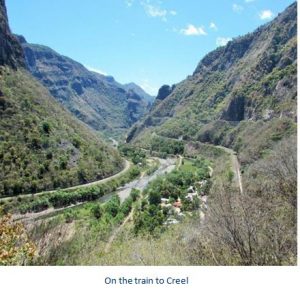 Fuerte (Sinaloa). This was the last highlight on our 90-Day Tour and, accordingly came right near the end, from Day 84 thru Day 88. Our destination was the Bugambilias Hotel, popular with RVers heading for the Copper Canyon.
Fuerte (Sinaloa). This was the last highlight on our 90-Day Tour and, accordingly came right near the end, from Day 84 thru Day 88. Our destination was the Bugambilias Hotel, popular with RVers heading for the Copper Canyon.
Our guide, Gabriel Romero (Caravanas de México), and his Quebec bride-to-be Angela, arrived shortly after our group and we had time for a brief Happy Hour, introductions and dinner across the street at a taquería. We were able to leave all the dogs and cats behind with Lisa, as she is terrified by heights and set out with Gabriel and Angela first thing in the morning. Fortunately for Lisa, the stay at the Bugambilias Hotel included access to electricity, wifi and couch comforts offered by one of the larger A Class RVs with a large flatscreen.
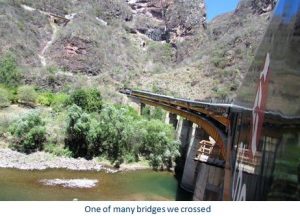 Within an hour of departure we were on our way on the Ferro-carril Chihuahua al Pacífico (Chihuahua-Pacific Railway), also known as El Chepe, linking the city of Chihuahua, Chihuahua, to the city of Los Mochis, Sinaloa and its port Topolobampo. Years ago, you could load your RV on flatdeck railcar, strap it down and away you go. That service ended some time ago.
Within an hour of departure we were on our way on the Ferro-carril Chihuahua al Pacífico (Chihuahua-Pacific Railway), also known as El Chepe, linking the city of Chihuahua, Chihuahua, to the city of Los Mochis, Sinaloa and its port Topolobampo. Years ago, you could load your RV on flatdeck railcar, strap it down and away you go. That service ended some time ago.
The train ride was nothing less than spectacular, which took most of the day. The Copper Canyon is the result of more than 60 million years of erosion, and covers an area four times as large as the Grand Canyon in the United States. The train ride includes 39 bridges and 87 tunnels (one of which is over a mile long!) and, at its peak, reaches an altitude of 8,056 feet above the Sea of Cortez.
Actual canyon elevations run as high as 9,500 feet above sea level, while the surrounding mountains rise to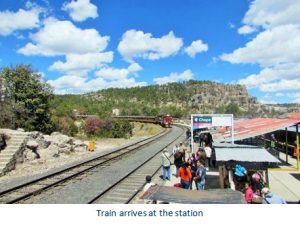 over 12,000 feet! Our journey to Creel, by train, was halted by a protest by farmers down the line and we unloaded at Divisadero, a natural lookout point, at over 4,000 ft (1200 m). We transferred to a school bus and in no time we arrived in Creel (Chihuahua).
over 12,000 feet! Our journey to Creel, by train, was halted by a protest by farmers down the line and we unloaded at Divisadero, a natural lookout point, at over 4,000 ft (1200 m). We transferred to a school bus and in no time we arrived in Creel (Chihuahua).
We spent 2 nights in a local hotel in Creel, treated to some lo-cal entertainment, toured around to some of the major site’s canyon vistas, took a cable-car ride, had an opportunity to try the zip line and were introduced to the Tarahumara community, traditional indigenous inhabitants of the Copper Canyon who are renowned for their long-distance running ability. Living in the canyons, they travel great vertical distances, which they often do by running nonstop for hours.
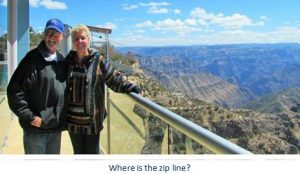 A popular Rarámuri community race called rarajipari, is played by kicking a wooden ball along the paths of the steep canyons. Originally, inhabitants of much of the state of Chihuahua, the Rarámuri retreated to the high sierras and canyons such as the
A popular Rarámuri community race called rarajipari, is played by kicking a wooden ball along the paths of the steep canyons. Originally, inhabitants of much of the state of Chihuahua, the Rarámuri retreated to the high sierras and canyons such as the
Copper Canyon in the Sierra Madre Occidental on the arrival of Spanish explorers in the 16th century.
Current estimates put the population of the Rarámuri in 2006 at between 50,000 and 70,000 people. Most 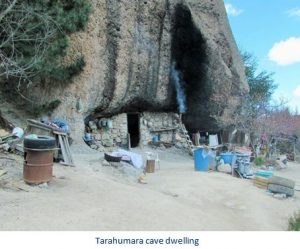 still practice a traditional lifestyle, inhabiting natural shelters such as caves or cliff overhangs, as well as small cabins of wood or stone. Staple crops are corn and beans; however, many of the Rarámuri still practice transhumance, raising cattle, sheep and goats.
still practice a traditional lifestyle, inhabiting natural shelters such as caves or cliff overhangs, as well as small cabins of wood or stone. Staple crops are corn and beans; however, many of the Rarámuri still practice transhumance, raising cattle, sheep and goats.
Almost all Rarámuri migrate in some form or another in the course of the year. Some communities accept government funding for building roads, restaurants and lodging to make the area attractive for tourists. Many other groups of Rarámuri maintain their independence by living in areas that are as far away from city life as possible. Their way of life is protected by the mountainous landscape. The Tarahumara language belongs to the Uto-Aztecan family.
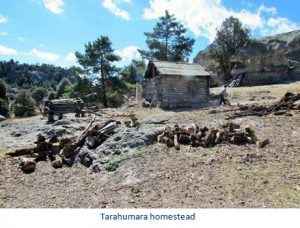 Although the daytime highs in the sun reached 20 degrees Cel-sius, the night time lows dropped below 0 degrees Celsius. Aside from tourism, Creel is a logging and mining town, hence it looks little like a traditional Mexican small town and more like you might expect to see in the American or Canadian Rockies.
Although the daytime highs in the sun reached 20 degrees Cel-sius, the night time lows dropped below 0 degrees Celsius. Aside from tourism, Creel is a logging and mining town, hence it looks little like a traditional Mexican small town and more like you might expect to see in the American or Canadian Rockies.
Fortunately, the protest ended as we were scheduled to return to El Fuerte. No one was looking forward to an 18-hour bus ride that was the only option if the train did not run. There are many companies offering Copper Canyon tours.
We recommend you make this trip; it is well worth it! See more pictures of our trip to the Copper Canyon on the next pages…
Download the full edition or view it online
Dan and Lisa Goy, owners of Baja Amigos RV Caravan Tours, have been making Mexico their second home for more than 30 years and love to introduce Mexico to newcomers.




